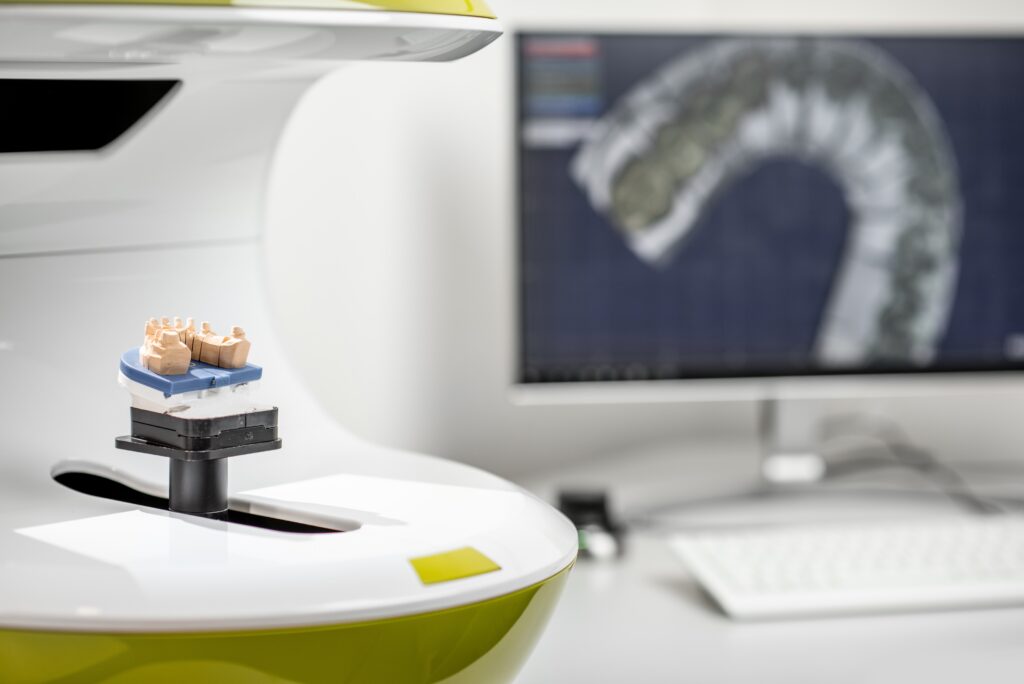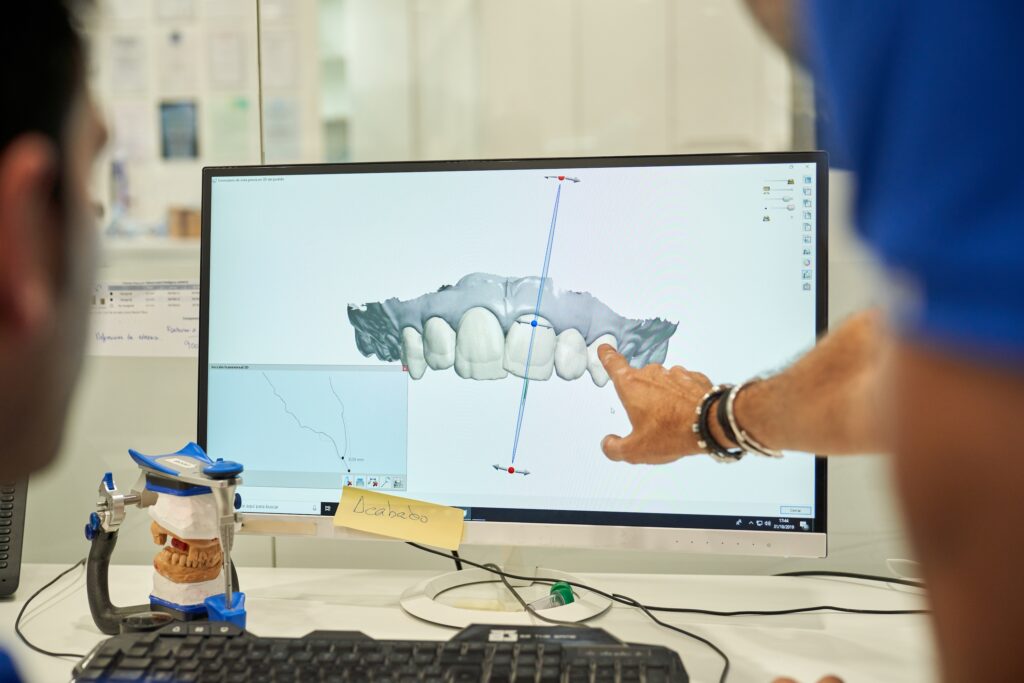CAD CAM technology stands for Computer-Aided Design (CAD) and Computer-Aided Manufacturing (CAM). It is a digital approach used in engineering, manufacturing, and design to streamline product development and production processes.
CAD refers to the use of software to create accurate 2D or 3D models models and drawings of products or structures. It improves design accuracy, visualization, and modification. CAM (Computer-aided Manufacturing) involves the use of computer software to control machine tools and automate manufacturing processes. Together, CAD and CAM enable industries to design, prototype, and manufacture products with minimal error and maximum efficiency.
Most people have only heard of CAD or CAM in the context of automotive manufacturing software. This is usually the use of computer-aided design and manufacturing to create high-precision tools and parts. But how does this relate to the dental field? Read on to learn more!
Understanding the Use of CAD CAM Technology for Dental Treatments
According to research, the first use of CAD (Computer Aided Design) and CAM in dental offices occurred in 1985. This changed the way dentists constructed dentures and restorations for lost teeth. Since then, most clinics have started to use them and Turkey has been in the forefront of this.
In this article, we will explore how CAD/CAM is used in dental treatment in Turkey. We will explain how this technology can benefit you as a patient.
What are CAD-Systems?
By definition, CAD systems are software used by drafters, designers, and modelers to create tools. For example, engineers and designers use CAD to create detailed 3D models and 2D drawings of various products.
Professionals who use these systems can go from creating simple designs to complex dental treatments in Turkey. This not only reduces the time it takes to come up with solutions, but also ensures that patients enjoy high quality.
What are CAM-Systems?
CAM systems, on the other hand, are software often used to program manufacturing equipment such as lathes and robots. CAM uses CAD modeling systems to automate and optimize processes.
As a result, dentists and practitioners experience minimized errors, which further reduces the time and cost of production. Simply put, CAM translates the designs developed in CAD into instructions for a physical object.

How do the Two Systems Interact in Dentistry?
Now that you know what CAD and CAM systems are, how do they work together in dentistry? The CAD/CAM system typically consists of several components that work together to design and produce quality dental restorations.
For example, an intraoral scanner serves as the foundation of the process. And the CAD software allows dental professionals to digitally design the ideal dental restoration solution.
The CAM software then uses the digital design from the CAD software to generate instructions for the 3D printers. The printers then produce the dental restorations for dental crowns or dental implants in Turkey. This is typically done by determining the toolpaths and required milling parameters. Depending on the solution, the restoration is milled from a solid block of material or printed in 3D CAD.
Most impressively, the CAD/CAM software has built-in quality control that improve the accuracy of the final restoration. This allows the dentist to preview the fit and occlusion of the restoration before the actual manufacturing process begins. Therefore, this minimizes errors and ensures that the patient receives a personalized treatment plan.
What are the Benefits of Using CAD CAM in Dentistry?
1) Precision and Accuracy
2) Better Patient Experience
Gone are the days when people were afraid to go to a dental clinic for fear of clamps, needles and pliers. With digital dentistry in Turkey, professionals do not have to use traditional impression materials, which can be quite uncomfortable.
CAD/CAM digital dentistry streamlines the entire restoration workflow. It reduces the time spent on appointments and the actual procedures. Additionally, it is seamless and smooth.
3) Enhanced Aesthetics
Just like fingerprints, no two people have the same teeth. Teeth vary in shape, structure, and even size. While this is a benefit to the patient, it requires the dentist to make a series of assessments to get the right fit.
Well, with CAD/CAM software, dentists are now able to customize the solutions to closely match the patient’s natural teeth. The system allows for quick manipulation of shapes, sizes and even colors of the teeth. This ensures that your smile is as intact as you want it to be.
4) Collaborative Numerically Controlled Design Process
As mentioned earlier, CAD and CAM software work hand in hand. One is instrumental in the design, while the other enables smooth operation via the milling and CAD control machines. In addition, the digital nature of the process allows for greater collaboration between the dentists and the lab technicians.
During the process, the dentists communicate with the technicians and make adjustments to the restorative design. They use the virtual preview tools to do this. This ability to fine-tune ensures that the final product meets the patient’s needs and aesthetic preferences.
What Level of Training and Expertise Do the Dental Staff Need to Operate CAD/CAM Systems?

However, the level of expertise and training required is highly dependent on the complexity of the systems. The training also depends on the specific tasks they need to perform. Here is a quick breakdown of the main levels of professionals who require training:
- Dentists: The dentists will be in charge of the treatment planning and determining the need for restorations. They will need a comprehensive understanding of dental anatomy, restorative materials, as well as digital design principles.
- Dental Assistants: The assistants will be required to capture the digital impressions. Therefore, they need to use tools such as intraoral scanners and equipment calibration. In their training, they get specific knowledge from the manufacturers on how to carry out their tasks.
- Dental Technicians: Technicians are responsible and fully accountable for the design and fabrication based on the dental restorations. They receive the digital scan from the dentist or dental assistant before developing the product. In addition to knowing how to use the specialized CAD/CAM software, they need knowledge in other areas. These include dental materials, milling machines, CNC machines and 3D printing technology.
Get Your Teeth Done in Turkey Today at Cosmedica Dental Clinic
Are you ready to transform your smile and your dental health? At Cosmedica Dental Clinic, we are ready to help. Whether you want to restore your smile, replace lost teeth, or simply enhance your appearance, our experts have it all covered. With our state-of-the-art technology and CAD/CAM systems, we can easily assess the condition of your teeth.
To get your teeth done in Turkey at our clinic, simply click on the ‘Free consultation’ button below. A form will open where you can enter your details for us to provide you with a free quote. Our specialists will recommend the most plausible treatments for you.
RESTORE YOUR SMILE WITH ADVANCED CAD/CAM TECHNOLOGY
Cosmedica Dental utilizes advanced CAD CAM technology to create precise dental restorations, ensuring a perfect fit. Experience faster, more comfortable treatments with cutting-edge digital dentistry!